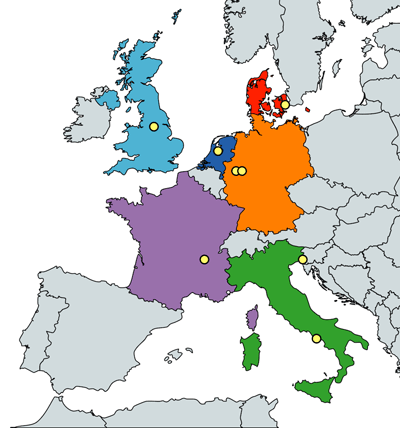AntiHelix: DNA helicases in genome maintenance: from molecular and cellular mechanisms to specific inhibitors as potential drugs
H2020-MSCA ITN (ETN) 2019
|
Helicases are ubiquitous enzymes, found in viruses, Bacteria, Archaea and eukaryotic cells. They act as motor proteins to separate or remodel DNA or RNA duplexes, using ATP as an energy source. Their activity is essential in nucleic acid metabolism, playing a key role in a variety of cellular processes, including DNA replication, repair, recombination, as well as RNA translation and transport. Due to their importance in the cell, they are emerging as a new class of antibacterial, antiviral and ant-cancer drug targets. To date, several genetic and biochemical studies have revealed the molecular and physiological functions of DNA helicases. In addition, protein three-dimension structural studies coupled with single molecule biophysical approaches have provided insights into structure-function relationships and reaction mechanisms of some key DNA helicases. The AntiHelix consortium includes academic and industrial partners with the aim of training young researchers, able to use a wide range of interdisciplinary approaches for the characterisation of the structure and function of medically relevant human helicases, to design novel inhibitors as putative drugs against cancer. |
 |
https://cordis.europa.eu/project/rcn/224674/factsheet/en
Aims of the AntiHelix Project
With a consortium with complementary expertise in Biology, Physics, Chemistry, Pharmacology and Clinical Oncology, and a strong commitment of companies involved in drug discovery or in the development of state-of-the-art biophysical instrumentation, we aim to:
- obtain a detailed picture of the mechanism of action and the physiological role of a number of DNA helicases that are implicated in human diseases
- discover specific inhibitors of those enzymes, which can then be tested as novel therapeutic drugs, especially for cancers
- address the need for training next generation scientists with complementary approaches and diverse techniques by secondments in different laboratories of the consortium
- promote a culture of collaboration between academic and private sectors and provide young scientists with the necessary experience and skills to exploit the full potential of research findings
- provide researchers at an early stage of their career with greater opportunities to access an increasingly competitive job market
- promote the values of Open Science and educate young scientists on the importance of developing a culture of openness, transparency, sharing, accessibility, integrity and reproducibility.
The objectives of the AntiHelix Research Programme are to:
- investigate the structure-function relationships and the reaction mechanisms of a group of medically important human DNA helicases (RECQ1, BLM, RECQ4, PIF1, RTEL1, FANCJ and DDX11)
- unveil the specific roles played by these DNA helicases in cellular genome maintenance pathways;
- discover and characterise novel helicase-specific small molecule inhibitors, which have the potential to be translated into anticancer drugs.
The objectives of the AntiHelix Training Programme are to:
- provide trainees with a critical understanding of the full range of interdisciplinary tools available to modern biologists
- expose trainees to the private sector and teach them the scientific and managerial aspects of the process of drug design
- expose the trainees to the value of Open Science and Responsible Research and Innovation, and educate them in the need for transparency, integrity and reproducibility in research
- develop transferable skills essential for career opportunities in a competitive European job market
- disseminate best practice and initiate a closer integration with the local PhD schools, with particular emphasis on the interaction with the private sector.